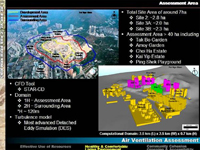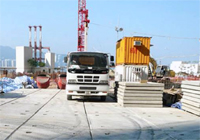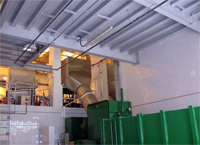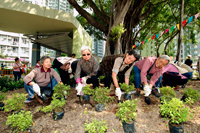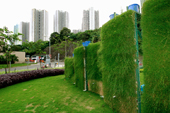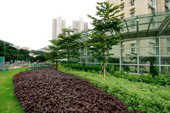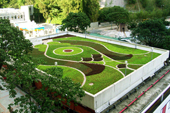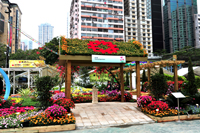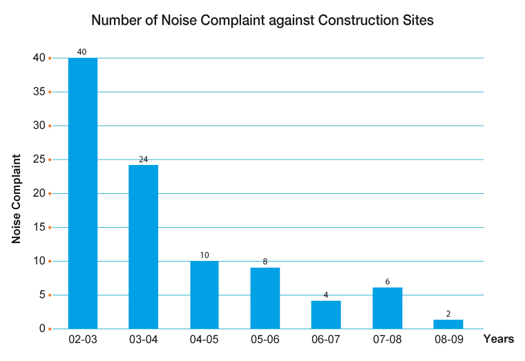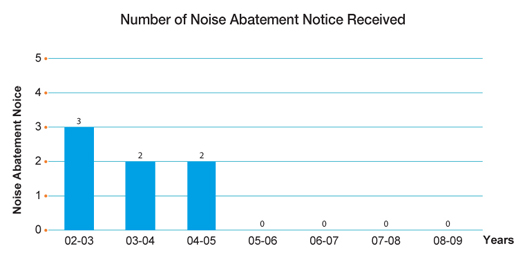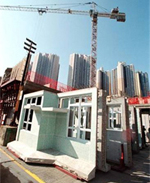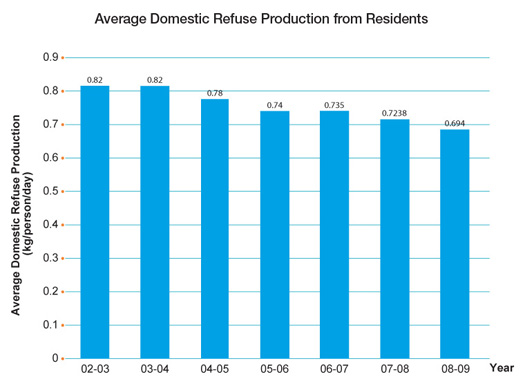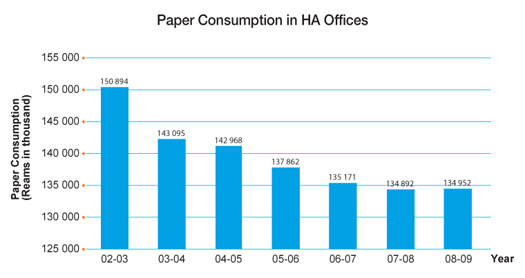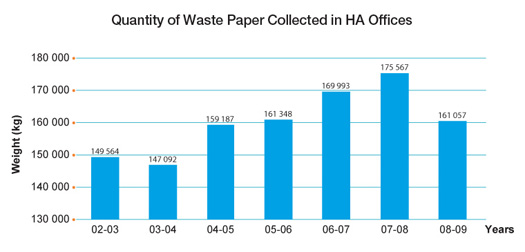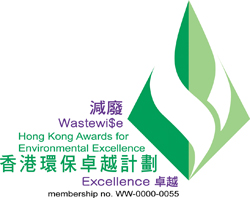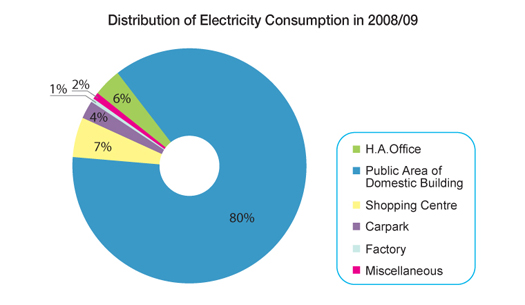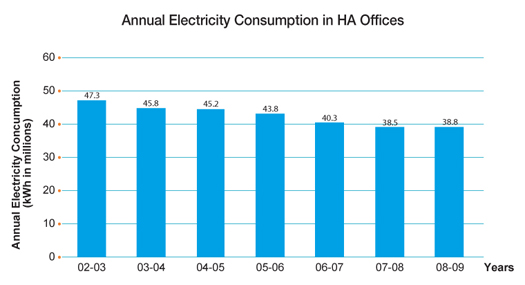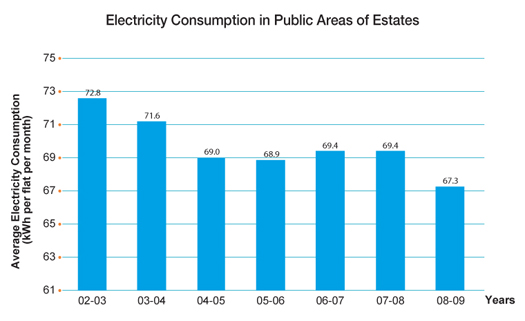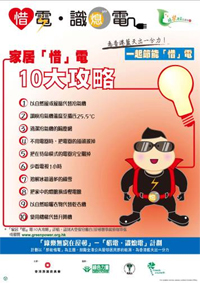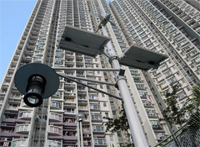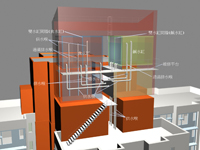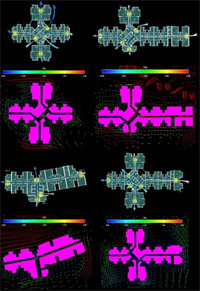Our Environmental Performance
In the past year, we continued to enhance the building designs and construction technologies of Public Rental Housing (PRH), improve estate management and maintenance, as well as implement stringent control on contractors so that the impact on the environment can be minimised. We encouraged residents and stakeholders to joining us in saving energy, reduce production of waste and promote recycling of waste, contributing to the sustainable development of Hong Kong.
Internally, our Development & Construction Division has prepared to further enhance their environmental management system to attain ISO 14001:2004 certification since 2008. With the approval of the Certification Body, the Certification would soon be received in June 2009.
We complied with all applicable environmental legislations in 2008/09. However, there were 12 conviction cases in environmental offences regarding our contractors' operations. Two cases on each environmental aspect were related to air and water respectively, while three were related to noise and five were related to waste.
| Awareness Arising Targets for 2008/09 | Progress |
|---|---|
| Review and monitor environmental awareness in PRH by reviewing the need for surveys and providing the results to the related sections for necessary improvements. | Fully Met |
Green Construction Methods
We continue to save energy and resources used in our operations. At the same time, we lead the industry with initiatives such as modular design, prefabrication and hard-paving construction methods. These techniques enhance building quality and site safety, minimise waste, generate less noise and reduce air pollution whilst eco-friendly and more durable materials help optimise the life-cycle of our buildings, they also benefit the environment.
Air
Air quality is always one of the key concerns in Hong Kong. The Housing Authority (HA) is actively working to improve air quality in the territory. Fully aware that construction methods, materials and designs are the major factors contributing to the increase of greenhouse effect, we have made the best use of environmentally-friendly construction methods as well as innovative technologies to reduce greenhouse gas emission and conserves resources.
Working for Better Air Quality
We are committed to maintain cleaner air with the involvement of the community to reduce the carbon footprint. In order to reduce the total carbon dioxide emissions, we are currently focusing on the following measures:
- Adopting both local and international standards to enhance the energy efficiency of building services installations, thus reducing indirect carbon emission
- Implementing the best practices to reduce dust and air emission
- Sharing our experience and knowledge of air pollution reduction measures at both local and international levels through conferences and seminars
We conducted indoor air quality assessment for our office building at Headquarters, Block 1, 2 and 3 of HA Headquarters were awarded the Indoor Air Quality Centificate (good class) by the Indoor Air Quality Information Center of Environmental Protection Department (EPD).
Air Ventilation Assessments
To continuously improve the air ventilation of the living environment, we looked into the effective solution to pose restriction to air flow for major development projects planned and designed after July 2006. 13 projects have been assessed since July 2006.
Modular Design & Hard-paved Construction Method
The techniques, apart from enhancing the quality of the building, reduce the generation of dust from our construction sites so that the air quality impact on the surrounding environment could be minimised.
Installation of De-odourisers
Estate Greening and Landscaping
Over the years, green design practices are always our major concern on our estate design. To extend the concept of a healthier and more sustainable living environment, we are working towards a more comprehensive greening programme for our estates. In 2008/09, we have introduced the installation of vertical greening panels and green rooftops in a number of our estates. We also continue promoting green living in our estates by organising green programmes or activities such as tree planting days, and "Green Delight in Estates programme".
| Greening and Landscaping Targets for 2008/09 | Progress |
|---|---|
| Provide green treatment (e.g. hydro-seeding and tree planting) to newly formed slopes. | Fully Met |
| Add new vegetation and promote greening in new housing estates to meet the minimum target of one tree per 15 PRH flats. Conduct tree surveys to ensure that this is met. | Fully Met |
| Upgrade the existing landscape in 18 selected PRH estates by improving soft landscaping through the Landscape Improvement Programme. | Fully Met |
| Promote local residents and the community to participate in early plant raising for new housing estates. | Fully Met |
| Promote a green environment at 20 estates with Estate Management Advisory Committees (EMACs) support through the provision of green activities in these estates. | Fully Met |
| Promote community involvement in greening of new PRH by introducing planting areas in master landscape layout plan in design stage. | Fully Met |
| Promote community participation in greening of existing PRH estates by developing community gardens in selected estates. | Fully Met |
| Improve the slope appearance in existing PRH estates by providing green treatment to hard surfaced slopes and improving on existing vegetated slopes. Also, chunam surfaces will be improved through hydro-seeding stone pitching and toe planters. | Fully Met |
| Enhance greening in PRH estates by allocating open areas in selected estates for setting up theme gardens. | Fully Met |
| Increase tenants' awareness and support of green by organising tree planting days in selected estates. | Fully Met |
Promotion of Green Living Environment
The programme "Action Seedling" has been launched since June 2007. Seedlings are given out to participants who nurture the plants at home until they are ready to be transplanted into the planters and gardens of the new estates. The first phase of the programme was completed with the support of hundreds of residents, students and community members from seven estates in helping to look after 5 000 seedlings which were subsequently replanted as part of estates' green landscapes. The second phase which involved seven estates is now ongoing.
Landscape Development
We have continued to carry out substantial landscape improvement works to maintain a better living environment for the residents. In 2008/09, all the newly formed slopes with green treatment covered a total area of 9 680 m2. In addition, we have planted about 7 600 trees, 687 700 shrubs and 97 700 annuals in our PRH Estates, and improved the existing landscaping in 18 estates covering a total area of 111 000 m2 under the Landscape Improvement Programme.
Thematic Gardens and Green Roofs
One of our major initiatives in estate greening is the greening of rooftops, walls, and introducing thematic gardens.
In 2008/09, we have set up thematic gardens in two estates namely the Butterfly Garden at Hoi Lai Estate and Red Plants Garden at Tai Wo Hau Estate. We have also set up green rooftops at Wo Lok Estate and Fu Shan Estate. The vertical greening panels, had been installed in Ching Ho Estate, Kwai Chung Estate, and Sau Mau Ping Phase 12 District Open Space and will be installed in the Eastern Harbour Crossing Site.
Greening Activities
To support the government initiatives, we have participated in the Leisure and Cultural Services Department's Hong Kong Flower Show 2009 by setting up a landscape garden that was designed around the idea of "Harmonious Garden". This design brought us the "Grand Award for Design Excellence". Our design has explicitly expressed our mission to the public, that is, "TO PROVIDE A HARMONIOUS LIVING ENVIRONMENT".
Noise Control
Being an environmental responsible authority, we continue our effort in providing a top quality living environment for our residents at all times. In 2008/09, we continued our on-going implementation programme on noise reduction measures by replacing noisy high-speed water pumps with quieter equipment in our PRH estates, and using prefabricated building elements in our construction sites.
| Noise Targets for 2008/09 | Progress |
|---|---|
| Reduce noise nuisance from water pumps in PRH estates by replacing 3 000 rpm water pumps with 1 500 rpm water pumps. | Fully Met |
Noise Complaints and Abatement Notices
In 2008/09, we received three noise complaints, two were from construction sites. The noise complaints were recorded and properly addressed by the concerned contractors. The rest was regarding noise generated from neighbourhood tenant.
The number of noise abatement notices issued by the EPD to PRH estates has been very low in past years. There was no noise abatement notice received in 2008/09.
Noise Mitigation at Construction Sites
Other initiatives have also been taken, e.g. the use of hydraulic concrete crushes, the use of modular design and prefabricated building elements in our new projects, to reduce noise impacts on the residents and neighbouring community during the construction phase.
Water Pump Replacement
Within our existing PRH estates, 19 noisy water pumps have been replaced with 1 500 rpm quiet water pumps during 2008/09 in order to reduce noise nuisance from water pumps. The programme of replacing all pumps is scheduled for completion by 2010.
Waste Management
With the continuous growth in population and limited disposal facilities, one of our key concerns is that Hong Kong will be running out of landfill space soon.
As one of the largest public agencies providing and managing housing facilities in Hong Kong, we always strives for the best practices to support waste reduction and recycling.
| Waste Management Targets for 2008/09 | Progress |
|---|---|
| Reduce Construction and Demolition (C&D) waste and ensure proper disposal by developing a Construction Waste Index through conducting surveys of C&D waste. | Fully Met |
| Increase domestic waste recovery rate for paper, aluminium cans, plastic bottles and used clothes by arranging publicity activities for all PRH estates. | Majority Met |
| Promote waste reduction through various publicity campaigns with the aim to reduce generation of domestic waste. | Fully Met |
| Implement Programme on Source Separation of Domestic Waste (SSDW) in all estates by phases. | Fully Met |
| Reduce A3 and A4 paper consumption in Housing Department (HD) offices by performing various initiatives to reduce paper consumption. | Fully Met |
| Collect waste paper in HD offices and implement various initiatives to encourage paper recycling. | Fully Met |
| Use environmentally-friendly paper in printing of all publicity materials by implementing its use as a pre-requisite in all printing jobs. | Fully Met |
| Enhance community awareness on environmental protection by launching campaigns to promote waste reduction and recycling in PRH estates and joint programmes with green groups and EMACs, including distributing environmental publicity materials to tenants. | Fully Met |
Management of Construction and Demolition Waste
The HA has taken various effective measures in managing C&D waste disposal. We practice recycling and reuse of demolition waste from our redevelopment projects as far as possible to lever the landfill burden. The C&D waste quantity from demolition of estates in 2008/09 was about 48 000 tonnes and the percentage to backfill was about 4.2%.
Programme on Source Separation of Domestic Waste
To facilitate and encourage more tenants to separate their waste for recycling, we implemented the Programme on SSDW in our PRH estates by phases since 2005. Up to end of 2008, a total of 120 PRH estates have participated in the programme. We will continue to introduce the SSDW Programme in 30 PRH estates each year and plan to include all PRH estates in this meaningful programme by 2012.
In 2008/09, a total of 120 estates took part in the competition under SSDW with 1 estate won the Gold Award, 5 estates won the Bronze Award and 114 of them received Certificates of Merit. Two of the above estates also received the Award for Co-operative Partnership from the EPD.
Recovery of Domestic Waste
In order to raise the resident awareness of domestic waste recovery, the HA set the waste reduction goals to recover four types of domestic waste in the PRH estates.
The following table presents the amount of waste recovered for recycling in PRH estates from 2006/07 to 2008/09.
| Waste Type | Quantity of Waste Recovered (tonnes) |
Recovery Rate (%) against estimated values | ||||
|---|---|---|---|---|---|---|
| 2006/07 | 2007/08 | 2008/09 | 2006/07 | 2007/08 | 2008/09 | |
| Paper | 13 025.3 | 14 748.2 | 14 193.7 | 12.30% | 14.30% | 14.37% |
| Aluminium Cans | 267.7 | 309.6 | 495.9 | 28.30% | 32.31% | 44.40% |
| Plastic bottles | 503.3 | 764.6 | 939.3 | 6.20% | 9.48% | 11.85% |
The recovery rate for paper is more or less the same as that of 2007/08, whilst there has been a significant increase in aluminium cans and plastic bottles recovery. However, only 618.1 tonnes used clothes was recorded from April 2008 to March 2009. It was slightly below the set target of 635.9 tonnes for used clothes recovery.
In addition, to enhance community awareness on environmental protection, joint programmes with green groups and EMACs were conducted such as "Collection of mooncake boxes", "Carnival with EMSD" in November 08 and "Green Carnival" in 2009.
Production of Domestic Refuse
After implementing various effective waste recovery programmes and campaigns, the average domestic waste production of our residents in 2008/09 was reduced to 0.6940 kg/person/day, a 4.12% reduction from the total domestic waste produced in 2007/08 and 15.3% reduction as compared with 2002/03.
Reduction of Paper Usage in Office
Internally, we have implemented a number of initiatives to reduce our paper consumption and enhance our paper recycling in all HD offices. In 2008/09, only 134 952 reams of paper were consumed, which was lower than our target consumption rate set against 2002/03 by 10.6%. In addition, the quantity of waste paper collected in the HA offices in 2008/09 was 161 057 kg, which is about 5% and 8% lower than the collection rate in 2006/07 and 2007/08, respectively.
"Wastewi$e" Label
The HA was awarded the "Class of Excellence Wastewi$e Label" of the Hong Kong Awards for Environmental Excellence organised by the Environmental Campaign Committee. The Scheme was established to encourage and assist Hong Kong companies and organisations in reducing the amount of solid waste generated during their operations. Each participating organisation had to set and meet a number of waste reduction targets and implement measures within a given time frame.
Energy
Energy conservation in Hong Kong has received increasing attention over the years. This is a crucial element in sustainable development and helps combat global warming. In order to support the government to combat greenhouse gas emissions, we commenced carbon audits on five of our buildings in August 2008. These audits will serve as benchmarks for identification of any future energy saving opportunities in our buildings. Reinforcing our energy-saving commitment, we have also commenced the installation of new energy saving "machine-roomless" lifts in several estates. The performance of the first "machine-roomless" lift has proven to be satisfactory.
| Energy Targets for 2008/09 | Progress |
|---|---|
| Reduce electricity consumption of landlord services installation in new domestic blocks by adopting Energy Codes and obtaining energy certificates for completed projects. | Fully Met |
| Explore and study application of more energy efficient equipment by completing trial installation of solar powered lamp poles, adjustment of lift counterweight settings and adopting a wider use of T5 fluorescent tubes. | Fully Met |
| Reduce energy consumption of office premises by performing various energy saving initiatives. | Fully Met |
| Explore and study application of green design for building services equipment. | Fully Met |
Energy consumption
With the implementation of various energy saving programmes, electricity consumption for our headquarters, offices and other premises was 615 172 000 kWh in 2008/09, 0.81% less than our consumption in 2007/08. This accounts for a reduction of over 3 500 tonnes of greenhouse gas emissions1.
1A default value for the emission factor of 0.7 kg/kWh is employed to account for Greenhouse Gas (GHG) emission associated generation of electricity to supply customers in Hong Kong (Source: Guidelines to Account for and Report on Greenhouse Gas Emissions and Removals for Buildings (Commercial, Residential or Institutional Purpose) in Hong Kong)
Within the HA offices, the achievement of meeting our annual electricity saving target have been reached since 2003. In 2008/09, we consumed 38 752 371 kWh of electricity which is 12.9% lower than the target consumption of 44 503 000 kWh. About 0.56% increment in total electricity consumption of our offices against 2007/08 was marked during the year. The increase in total electricity consumption was due to the increase in total number of HA offices.
The public areas of domestic buildings in our estates represent the highest proportion of HA's annual electricity consumption. The total electricity consumption of the public areas in 2008/09 was 493 704 250 kWh which is 0.084% less than that in 2007/08. This resulted in a reduction of almost 300 tonnes CO2e emissions. In terms of average monthly consumption per flat, this equivalents to a drop of about 3%, from 69.4 kWh/flat/month in 2007/08 to 67.3 kWh/flat/month in 2008/09.
In 2008/09, the fuel consumption of the HA's vehicle fleet was 93 338 litres, which is approximately 1% less than that in 2007/08. This links to a reduction of about 1.5 tonnes of carbon dioxide emissions2 to the atmosphere.
2 Carbon dioxide emission is calculated using mobile combustion carbon dioxide emissions calculation tool version 1.3 developed by GHG Protocol Initiative. Assuming only gasoline is consumed by the HA's vehicle fleet, CO2 emission = GJ energy (Gasoline used in litre x 0.0344 GJ/unit) x Emission Factor (69.250 kg CO2/GJ)
Energy Conservation
We always strive for a balance between energy saving and aesthetics in our development. In 2008/09, we have encouraged natural light design for energy saving.
Lighting modification works that optimised the use of daylight in all of our H-type blocks were completed in 2008/09 with an overall expected electricity saving of 1 680 000 kWh per year.
A three-year programme to replace T8 with the more energy efficient T5 fluorescent tubes for exit and directional signs also commenced in 2008/09, with the modification of 67 blocks completed so far. T8 fluorescent tubes in 14 000 exit signs were replaced by energy-efficient T5 tubes with the total annual electricity energy saving of 1 470 000 kWh.
To show our support on energy conservation, we worked with our stakeholders to enhance energy saving in our estates. We participated in the "One-hour-long Lights Out" campaign organised by Friends of the Earth (HK) (FoE(HK)) on 21 June 2008 and a similar campaign entitled "Earth Hour 2009" organised by the World Wide Fund for Nature Hong Kong on 28 March 2009. All non-essential lighting, such as decorative or promotional lightings were switched off between 8:30 and 9:30pm on both evenings to draw public attention to global warming and promote energy conservation. Five estates were also chosen to participate in FoE(HK)'s "Power Smart 2008" energy saving competition. Participants were required to reduce electricity consumption in their estates' public areas over a period of 90 conservative days.
Since 2002, all of our projects have been designed accordingly to the Building Energy Codes issued by the Electrical and Mechanical Services Department (EMSD) in order to meet the energy efficiency requirements on lighting, electricity, air-conditioning, lift and escalators installations. Since the adoption of the Codes, we have obtained a total of 180 energy certificates. Coupled with the implementation of other energy saving design features, it is estimated that about 30% of the annual electricity consumption of the public areas of our new domestic buildings can be saved.
Seeking to improve energy saving even further, new technologies to conserve yet more energy in our building projects are under trial. These include the installation and performance monitoring of solar panels and LED lighting at Lam Tin Estate, as well as the planned implementation of hybrid ventilation systems to regulate the natural cooling of air-conditioning systems for retails at Yau Tong Estate and the development at Choi Wan Road.
Furthermore, to follow an environmental initiative advocated by EMSD, the Shopping Centre at Kai Tak Site 1A will adopt a district cooling system for better energy efficiency, amid other environmental considerations such as elimination of noise and heat emissions. Moreover, for educational purposes, every newly completed project is provided with a couple of pole lamps or other similar lighting fittings powered by renewable energy, a total of 18 lighting fittings installed up to the end of March 2009.
Water
Careful management of water has allowed us to achieve continuous improvement in water consumption and water quality. Even though we have provision of a reliable and safe water supply system to PRH, we will continue to strive for a high quality water supply service. We understand that our practices today will have profound effects on our future.
| Water Conservation Targets for 2008/09 | Progress |
|---|---|
| Reduce flushing water consumption by conducting trial schemes in new projects, e.g. pilot project at Shek Lei Phase 10 and corresponding performance reviews. | Fully Met |
| Reduce potable water consumption for installations under landlord control in PRH estates by using self-stopping water taps and conducting re-plumbing programmes to minimise pipe bursting and leakage as well as studying the feasibility of using rain water for plant watering and general cleansing. | Fully Met |
| Continue to reduce water consumption at HA Headquarters by performing water saving initiatives as appropriate. | Fully Met |
The water consumption in 2008/09 is 14 489 m3 which is 3.4% lower than the target consumption of 14 993 m3.
Common W-trap Waste Water System
During the design and construction for new estates, providing clean and hygiene living environment has been one of our primary considerations in building a sustainable living environment. One of the most remarkable steps was the development of "common W-trap" waste water system, which was developed in collaboration with the City University of Hong Kong after the outbreak of SARS epidemic. The design tackles the problem of spreading diseases via dried-up u-trap floor drains in a satisfactory manner. Phase 3 of Yau Lai Estate at the Eastern Harbour Crossing site was being selected to be the first development to study its implementation during the year. In view of the trial's positive results, this design is now being adopted in all of our new estates.
Reduce Flushing Water Consumption
Since 2002, dual-flush cisterns have been installed in the washrooms at HA headquarters to test their water saving potential, durability and maintainability. With this positive trial result, we have carried on another pilot project at Shek Lei Phase 10 to install dual-flush cisterns. The result of this pilot project will be closely monitored and evaluated before wider applications in other new PRH estates.
Harvest Rain Water for Irrigation and Twin Water Tanks
On trial basis, to reduce water consumption, we will install collection systems to harvest rain water or air-conditioning condensate for irrigation at the Eastern Harbour Crossing Site Phases 5 and 6 and Yau Tong Redevelopment Phase 4 respectively, while dual flushing systems have been adopted in Aldrich Bay Phase 5.
Where practicable, twin water tanks have been/will be installed at roof level to reduce the chance of interruption of water supply to our residents, and to reduce the amount of wash out from water tank cleansing activities.
Construction Site Water Management
Contractors are required to apply licence from EPD for any effluent discharges to public drainage system. Wastewater should be treated with silt removal and pH adjustment via adequately designed treatment facilities prior to discharge into the approved discharged point as per the discharge license. There are discharge requirements on water quality in terms of pH Value, Suspended Solid and Chemical Oxygen Demand to be complied with. Water samples should be collected and tested by approved laboratory once every 3 months. For individual contractors accredited with ISO 14001, more frequent water samples are to be tested. Test results should be kept for inspection by EPD. Water used in wheel-washing bay shall as far as practicable be re-cycled after sedimentation.
Material Usage and Control of Hazardous Materials
To further reduce our environmental and safety impact on the neighbourhoods and community at large, prefabrication of structural components, modular design using prefabricated building units manufactured off-site and hard-paved construction methods were adopted in our construction sites. Applying these techniques leads to enhancement of the building quality and site safety as well as reduction in waste, noise and other environmental pollutions. Environment-friendly and more durable materials are also selected under our green procurement practice, which help optimise the life cycle of the buildings, and hence benefit the environment.
The following targets have been set for material usage and control of hazardous materials.
| Material Usage and Control of Hazardous Materials for 2008/09 | Progress |
|---|---|
| Further abate the remaining asbestos-containing materials in existing HA managed properties by implementing asbestos abatement programme through estate redevelopment programme and asbestos removal works. | Fully Met |
| Use of softwood timber doors in PRH estates. | Fully Met |
Use of Softwood Timber Door in PRH Estates
From 2007/08 till now, we carried on with a pilot project using softwood timber doors in the construction of Eastern Harbour Crossing Phase 4 (EHC4). These doors were made of timber from sustainably managed forests and with the certification from the Forestry Stewardship Council (FSC). The percentage of certified timber material from sustainable source in each FSC certified door is 86.6% while 16.2% of doorsets in EHC4 that are FSC certified doors. The results of using softwood timber doors, together with the quality assurance and traceability issues of using FSC products, are currently under reviewed by the EHC4 project team.
Use of Recycled Material
Over 99% of the copy papers are recycled paper and environmentally friendly paper have been used in printing of publicity materials.
Use of Pulverised Fuel Ash (PFA)
We have also encouraged our contractors to use reusable metal hoardings, metal formwork and prefabricated building elements. We have estimated that approximately 26 000 tonnes of timber was saved from our construction projects. By replacing cement with PFA in the concrete mixes, we saved 32 000 tonnes of cement.
Asbestos Abatement Programme
The Asbestos Abatement Programme continued in 2008/09 in the Comprehensive Redevelopment Programme. Asbestos in 8 blocks have been removed and 3 blocks have been demolished up to late February 2009.
Micro-Climate Studies
The Micro-Climate Studies was first introduced in 2001. They provide the starting point for our green design. Now used in the design and development in all of our new estates, these studies employ computer simulations to assess the site's micro-climate in terms of airflow and wind speeds, solar heat levels and ambient noise levels to determine the best use and environmental quality of the external space. These studies facilitate us to build better living spaces that introduce as much natural ventilation and daylight as possible, and also ensure that buildings are positioned to enjoy the best from the natural environment. Aiming to provide a healthier and more comfortable living environment for residents, while minimizing pollution and saving energy, we have applied these studies in over 33 developments as of March 2009. Choi Ying and Upper Ngau Tau Kok Estates, completed during the year, were among the first developments to conduct these micro-climate studies in their design and construction.
Biodiversity Assessment
In our philosophy, development should never significantly impact our environment. We strive to create minimal disturbance to the natural environment, including the biodiversity. Biodiversity assessment is to be carried out for developments situated close to areas with high ecological value. So Uk Estate redevelopment is a typical example. Its rich vegetation in the existing estate is to be preserved as an integrated landscape strategy for the new development. Survey of the bio-diversity content inside the estate and its proximity to the Lion Rock country park (Eagle Nest) will be carried out shortly. Similar to the Shui Chuen O, which is embraced by the Ma On Shan/Tsz Wan Shan country park with 2 water-courses identified in the vicinity, survey of the biodiversity content of the country park will also be carried out in 2009/10.
















